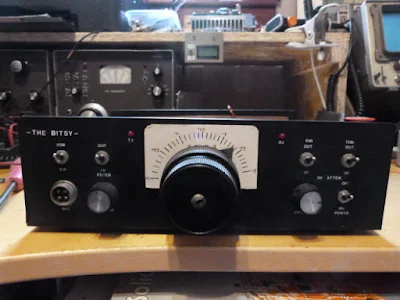This is such a beautiful project: it involves DSB, homebrew, troubleshooting, George Dobbs, SSDRA, J310s, a box kite, and ham radio nostalgia. I was struck by how similar the Bitsy looks to some of my own DSB creations (but the Bitsy is nicer). I'm really pleased to find a DSB project coming out of the UK -- when I was there, DSB was kind of frowned upon by spectrum preservation zealots. I say there is plenty of room for the very few homebrew DSB rigs that will ever grace the airwaves with their presence. Thanks John. Have fun with all your projects. 73 Bill
Hi Bill
In the early 80's I built and experimented with Direct Conversion Receivers and had a lot of fun with them. I came across a 40M DC cw transceiver by the late Rev. George Dobbs in a Practical Wireless magazine and decided to build it. Whether I was just lucky I'm not sure but it worked first time and I had several cw contacts with it. It was called “The PW Severn”. I then discovered DSB and looked into modifying the wee rig. I gave George a phone, no internet in those days, and explained what I was proposing to do and if there was any advice he could offer. His reply was , “it should work so try it and see, any problems get back to me”. It worked and I had a lot of fun with it. I used to take it portable and with a box kite to support a long wire and worked all over Europe.
It was after reading and learning about
circuits and home brewing I wondered if I could design and build a DSB
transceiver of my own. I had plenty of articles and most importantly a copy of
Solid State Design, now well thumbed.
So the “Bitsy” was born. It is an 80M DSB
transceiver. The PA produces about 2 watts. I took what I thought was the best
for each module and built it using six circuit boards which I designed and
etched myself. Nowadays I use the Manhattan method for one of circuits. It is
much easier and quicker.
Like most home brew projects, the fun is in
the building and the wee rig lived in a box for several years. Probably over
30. My doesn't time fly. I came across it again while looking through my boxes
and decided to give it an airing. Expecting it to work on power up I was quite
shocked when it produced nothing on both receive and transmit. After staring at
it for a couple of minutes I unscrewed the lid and studied the wiring for a dry
joint. Nothing so I switched on my Digital Multimeter and Oscilloscope. I soon
found out that the output from the VFO was missing. The VFO uses one FET and
two PNP Transistors for the buffers. The scope soon proved that the FET was
faulty. I used an MPF102. These are hard to get so I replaced it with a J310.
While I had the VFO out I also replaced the 9.1v zener diode, which provides a
regulated voltage for the FET, with a 78L05 connecting the centre pin via a
580ohm resistor to earth. This gives me a 9.3v regulated supply for the
oscillator. It is now back in full working condition.
With the Covid 19 epidemic I, like a lot of
the Amateur Radio fraternity, am spending a lot of time in the shack and
looking for new projects. I am buying back my old FT200 which was my first rig.
An old friend and lapsed amateur has still got it and agreed to sell it back to
me. It is still in a good condition for being nearly 50 years old and just
needs some TLC. When it is finished it will take pride of place beside my
restored Heathkit SB104A. And they say nostalgia is not what it used to be!!
John Forsyth
GM4OOU




No comments:
Post a Comment